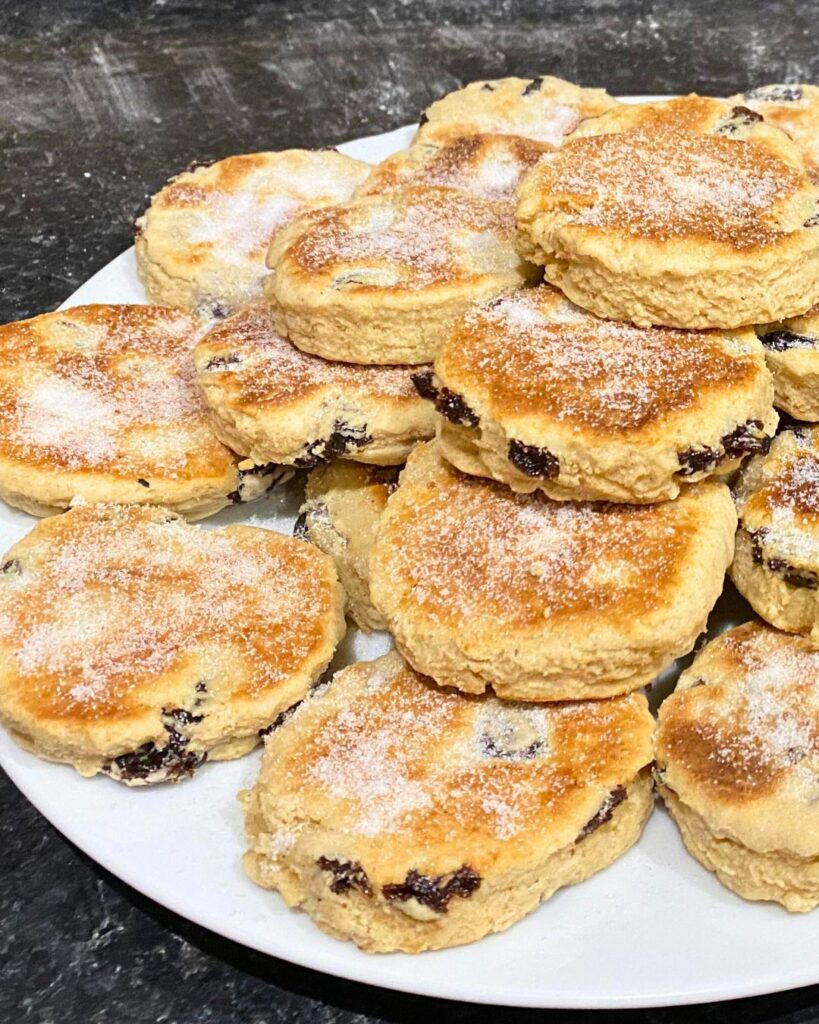I remember the warmth of the kitchen, the scent of mixed spice filling the air, and the crackling sound of the cakes sizzling on the cast iron griddle. These memories are the reason why I’m excited to share a recipe from none other than Mary Berry, a name synonymous with British baking excellence. Her version of Welsh cakes includes plump currants and a hint of spice, making each bite a perfect blend of sweet and aromatic flavors.
These cakes are traditionally served warm, sprinkled with sugar, and slathered with butter. While they are perfect in their classic form, I can’t help but play around with the recipe a bit. Sometimes I like to add a pinch of nutmeg or swap the currants for dried cranberries to give it a new twist. Each variation brings a new flavor profile, making this versatile treat a delightful experiment each time.
The simplicity of Mary Berry’s Welsh cakes recipe also means you can whip them up in no time—a perfect last-minute treat for any unexpected guests or a quick family snack. In this blog post, we’ll delve into not only how to make these irresistible treats but also explore their rich history and some personal tweaks that might just make them your new favorite go-to snack.
So, grab your apron, and let’s take a nostalgic journey to the heart of Wales with every bite of these delectable Welsh cakes.
How to Prepare The Welsh Cakes
Ingredients:
- 6 oz butter
- 1 large egg
- 2 tbsp milk
- 4 oz currants
- 4½ oz caster sugar
- 12 oz self-raising flour
- 2 tbsp baking powder
- ¾ level tsp ground mixed spice
- Extra caster sugar for sprinkling
How to:
Gather your equipment, which should include a 3-inch plain round cutter, a griddle, or a heavy-based frying pan. Begin by heating the griddle over medium heat and applying a light coat of oil to prevent sticking.
In a large mixing bowl, combine the self-raising flour and baking powder. Work the butter into the flour mixture with your fingers until it looks like fine crumbs. Stir in the caster sugar, currants, and mixed spice to distribute them evenly.
Whisk the egg and milk together in a separate container. Pour this mixture into your dry ingredients, stirring until a firm dough forms. If the dough feels dry, add a touch more milk to achieve the right consistency.
On a surface lightly dusted with flour, roll out your dough to about a ¼ inch thickness. Use your round cutter to cut out pieces of the dough.
Place the rounds on the preheated griddle and cook each side for about 3 minutes, or until they turn a lovely golden color. Ensure the heat is low enough so they cook through without burning.
Once cooked, transfer the Welsh cakes to a wire rack to cool slightly before sprinkling with a bit more caster sugar.
Enjoy these cakes fresh and warm, ideally on the same day they are made.
FAQs:
What is the ideal thickness for rolling out the dough for Welsh cakes?
The dough should be rolled out to a thickness of ¼ inch. This ensures that the cakes cook evenly and remain tender. Additionally, maintaining this specific thickness helps the cakes to achieve the right texture and allows them to cook through properly without burning.
Can I use a regular frying pan if I don’t have a griddle for making Welsh cakes?
Yes, you can use a regular frying pan if a griddle is not available. Ensure the frying pan is heavy-based to distribute the heat evenly. Moreover, it should be heated and lightly greased with oil before cooking the cakes to prevent sticking and to achieve a golden-brown finish.
How do you know when Welsh cakes are cooked properly on the griddle?
Welsh cakes are cooked properly when they are golden brown on each side, which typically takes about 3 minutes per side on a low heat. Furthermore, it’s important to cook them slowly to ensure the centre cooks through without the outside burning.
Is it necessary to use caster sugar for sprinkling on Welsh cakes, or can other types of sugar be used?
Caster sugar is preferred for sprinkling on Welsh cakes due to its fine texture, which dissolves quickly and provides a delicate sweetness. However, if unavailable, you can substitute it with other fine sugars. This adaptation might slightly alter the texture or sweetness profile of the finished cakes.
What adjustments should be made if the dough is too dry or stiff while preparing Welsh cakes?
If the dough is too dry or stiff, gradually add a little more milk until the desired consistency is achieved. This helps to form a firm but pliable dough that rolls out smoothly and doesn’t crack. Moreover, ensuring the dough is not too dry is crucial for the texture of the cakes.

Welsh Cakes
Ingredients
- 12 oz self-raising flour
- 2 tbsp baking powder
- 6 oz butter
- 4½ oz caster sugar
- 4 oz currants
- ¾ level tsp ground mixed spice
- 1 large egg
- 2 tbsp milk
- Caster sugar for sprinkling
Instructions
- You will need a griddle or frying pan, and a 3 inch plain round cutter.
- Prepare a griddle or heavy-based frying pan by heating and lightly greasing with oil.
- Measure the flour and baking powder into a large bowl and rub in the butter with your fingertips until the mixture resembles fine breadcrumbs. Add the sugar, currants and spice.
- Beat the egg and milk together, then add this to the mixture and mix to form a firm dough, adding a little more milk if necessary. Roll out the dough onto a lightly floured work surface to a thickness of ¼ inch then cut into rounds with a 3 inch plain round cutter.
- Cook the dough rounds on the hot griddle on a low heat for about 3 minutes on each side until golden brown (be careful not to cook them too fast, otherwise the centres will not be fully cooked). Cool on a wire rack then sprinkle with caster sugar. They should be eaten on the day of making, served buttered.

